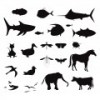Don't let their small size fool you. Tardigrades, or 'water bears', are really tough animals. According to a review published in the American Scientist, these microscopic invertebrates can survive extreme variations in temperature from near absolute zero (-459 deg F) up to +302 deg F. They can also tolerate pressures that are 6 times greater than the deepest ocean, exposure to ionizing radiation (UV and x-ray) and the vacuum of space, as well as exposure to carbon dioxide and monoxide, nitrogen and sulfur dioxide. What's more, they can survive nearly complete dehydration, an ability called anhydrobiosis. To survive these extreme challenges, the animals go through a state called cryptobiosis during which time they shut down metabolism until the threat is over. For animals that live in moist environments with periodic dry spells, dehydration is a threat.
A new study published in Nature Communications examined whether water bear cellular tolerance to dehydration and radiation could be transferred to human cells. The researchers suspected that because both these threats damage DNA, water bears may use the same protein to protect their tissues. The team sequenced the genome of a species of water bear (Ramazzottius varieornatus), then inserted portions of the genome into cultured human cells. Just as they had suspected, they discovered a gene called Dsup that can prevent DNA damage caused by exposure of the cells to x-rays as well as dehydration.
The hope is that this discovery may lead to therapies to help protect people receiving radiation therapy or those who work with radiation. It may also help in the development of crops that can tolerate extreme temperatures or radiation - farming on Mars anyone?
Given their amazing tolerance to extreme environments, I am sure the water bear genome sequence will lead to additional discoveries of protective proteins.
Sources:
Video By Halberg K, J?rgensen A, M?bjerg N [CC BY 4.0 (http://creativecommons.org/licenses/by/4.0)], via Wikimedia Commons
